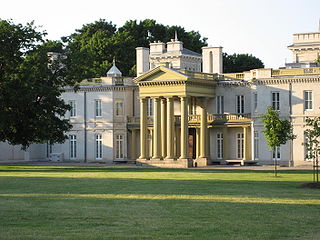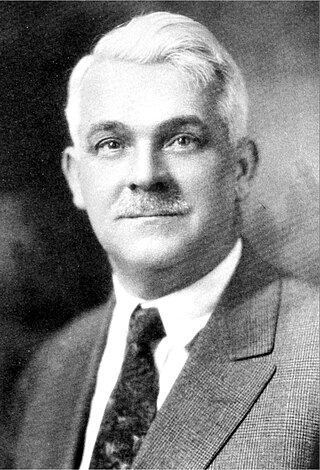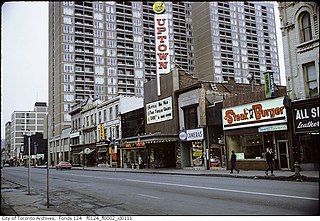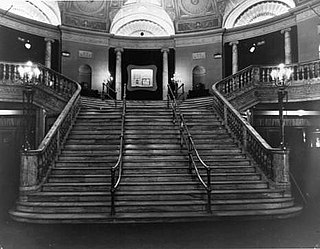
Richmond Hill is a city in south-central York Region, Ontario, Canada. Part of the Greater Toronto Area, it is the York Region's third most populous municipality and the 27th most populous municipality in Canada. Richmond Hill is situated between the cities of Markham and Vaughan, north of Thornhill, and south of Aurora.

Yonge Street is a major arterial route in the Canadian province of Ontario connecting the shores of Lake Ontario in Toronto to Lake Simcoe, a gateway to the Upper Great Lakes. Ontario's first colonial administrator, John Graves Simcoe, named the street for his friend Sir George Yonge, an expert on ancient Roman roads.

The Royal Alexandra Theatre, commonly known as the Royal Alex, is an historic performing arts theatre in Toronto, Ontario. The theatre is located at 260 King Street West, in the downtown Toronto Entertainment District. Owned and operated by Mirvish Productions, the theatre has approximately 1,244 seats across three levels. Built in 1907, the Royal Alexandra Theatre is the oldest continuously operating legitimate theatre in North America.

Dundurn Castle is a historic neoclassical mansion on York Boulevard in Hamilton, Ontario, Canada. The 1,700-square-metre (18,000 sq ft) house took three years and $175,000 to build and was completed in 1835.

Thomas White Lamb was a Scottish-born, American architect. He was one of the foremost designers of theaters and cinemas of the 20th century.

The Ed Mirvish Theatre is a historic performing arts theatre in Toronto, Ontario, located near Yonge–Dundas Square. Owned and operated by Mirvish Productions, the theatre has approximately 2,300 seats across two levels. There are two entrances to the theatre, located at 263 Yonge Street and 244 Victoria Street.

The Garden District is a neighbourhood in downtown Toronto, Ontario, Canada. The name was selected by the Toronto East Downtown Residents Association (TEDRA) in recognition of Allan Gardens, an indoor botanical garden located nearby at the intersection of Carlton and Jarvis Streets. The Garden District was officially designated by the Mayor and Toronto City Council in 2001, while TEDRA has since been renamed the Garden District Residents Association. Part of the neighbourhood is within official City of Toronto neighbourhood of Moss Park.

The Uptown Theatre was a historic movie theatre in Toronto, Ontario which was demolished in 2003. The entrance to the theatre was located on Yonge Street just south of Bloor. Like many theatres of the time it was constructed so that only the entrance was on a major thoroughfare while the main building fronted on a side street. A bridge connected the two buildings.

205 Yonge Street was formerly a four-story Bank of Toronto building built in 1905 in Toronto, Ontario, Canada. It was designated under the Ontario Heritage Act in 1975. The E. J. Lennox-designed structure has a domed roof and Corinthian columns on the front, and it is an example of neoclassical architecture.

The Toronto Normal School was a teachers college in Toronto, Ontario, Canada. Opened in 1847, the Normal School was located at Church and Gould streets in central Toronto, and was a predecessor to the current Ontario Institute for Studies in Education. The Royal Ontario Museum, the Ontario College of Art & Design and the Ontario Agricultural College all originated at the Normal School's campus and the provincial Department of Education was also located there. Officially named St. James Square, the school became known as "the cradle of Ontario's education system". The school's landmark Gothic-Romanesque building was designed by architects Thomas Ridout and Frederick William Cumberland in 1852. The landmark building was demolished in 1963, but architectural elements of the structure remain on the campus of Toronto Metropolitan University.

The Capitol Cinema was the largest movie theatre ever built in Ottawa, Ontario, Canada, and was the city's only true movie palace. Opened in 1920, the 2530-seat cinema was regarded as one of the best cinemas designed by famed theatre-architect Thomas W. Lamb.

Downtown Toronto is the main central business district of Toronto, Ontario, Canada. Located entirely within the district of Old Toronto, it is approximately 16.6 square kilometres in area, bounded by Bloor Street to the northeast and Dupont Street to the northwest, Lake Ontario to the south, the Don Valley to the east, and Bathurst Street to the west. It is also the home of the municipal government of Toronto and the Government of Ontario.

Downtown Yonge is a retail and entertainment district centred on Yonge Street in Downtown Toronto, Ontario, Canada. The Downtown Yonge district is bounded by Richmond Street to the south; Grosvenor and Alexander Streets to the north; Bay Street to the west; and portions of Church Street, Victoria Street, and Bond Street to the east. All property owners and commercial tenants within these boundaries are members of the Downtown Yonge Business Improvement Area association, founded in 2001.

The Grand Opera House was an opera house and concert hall located in Toronto, Ontario, Canada.
LARES is an electronic sound enhancement system that uses microprocessors to control multiple loudspeakers and microphones placed around a performance space for the purpose of providing active acoustic treatment. LARES was invented in Massachusetts in 1988, by Dr David Griesinger and Steve Barbar who were working at Lexicon, Inc. LARES was given its own company division in 1990, and LARES Associates was formed in 1995 as a separate corporation. Since then, hundreds of LARES systems have been used in concert halls, opera houses performance venues, and houses of worship from outdoor music festivals to permanent indoor symphony halls.

The Toronto Theatre District is a part of the Toronto Entertainment District in Downtown Toronto that contains the largest concentration of stage theatres in Canada. It is the third largest English-speaking theatre district in the world, after West End in London and Broadway in New York City.

The Thornton–Smith Building, located at 340 Yonge Street, is a prominent heritage building in the heart of downtown Toronto, Ontario, Canada. Since the completion of the building in the twenties, Yonge Street has seen many transformations and while tenants in the building have reflected these changes The Thornton–Smith Building itself has remained true to its original architecture.

Massey Tower is a new complex in Toronto, Ontario, Canada, spanning the block below Shuter Street, between Yonge and Victoria streets. The complex's northeast corner added much-needed backstage space to historic Massey Hall. To the south of the complex lies the historic Elgin and Winter Garden Theatres. The Yonge Street facade uses the 1905 Canadian Bank of Commerce headquarters at 197 Yonge Street, vacant since 1987. The complex's tower rises 60 storeys and stands 208.3 metres (683 ft) in height.

The Capitol Theatre is a historic theatre in Windsor, Ontario, Canada. Opened on December 30, 1920, by the Loew Theater Company owned by Marcus Loew at a cost of approximately CA$600,000. Designed by Toronto architect Thomas White Lamb, it was the largest single floor theatre in Canada at the time, with 1,995 seats.

Shea's Hippodrome was a historic film and play theatre in Toronto, Ontario, Canada. The Hippodrome was located in downtown Toronto, at the southwest corner of Albert and Bay streets. At its opening in 1914, it was the largest movie palace in Canada, and one of the largest vaudeville theatres in the world. The Hippodrome included 12 opera boxes, a Wurlitzer organ, as well as a full-size orchestra pit. It debuted some of Canada's first non-silent films. It was built by brothers Jerry and Michael Shea and situated directly across from Toronto's City Hall. The Hippodrome was operated by Famous Players and managed for decades by Leonard N. Bishop. It was demolished in 1957 to make way for Toronto's new City Hall.























